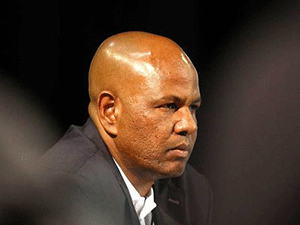
[miningmx.com] – COLLECTIVE bargaining is often described as a game. As such, it is mostly likened to a boxing match in which labour legislation are the rules of the game and the referee is represented by the state.
Wage negotiations in the gold industry this year, however, is more like a game of chicken – that reckless game of daredevils racing head-to-head at each other to determine who will blink and swerve to avoid a direct and fatal crash.
There is little doubt that the future of gold mining is at stake in the wage round this year. A joint study commissioned by the Chamber of Mines and the Department of Mineral Resources in 2003, undertaken by the international consultants group Monitor, showed that there would be only two gold mines left in South Africa by 2014: South Deep and Target. It was based on the reserves and resource statements in the annual reports of the different gold companies.
A lot has happened in the 12 years that passed since then. An enormous resource cycle with a strong uptick in the gold price, exchange rate volatilities and other variables prevented Monitor’s sombre predictions from becoming reality.
Our gold production figures, nevertheless, declined from 354 tonnes in 2007 to 168 tonnes last year, but there are still some 120,000 people working in our gold mines.
It is, however, undoubtedly still a very vulnerable sector.
The gold price declined from $1,700/oz in 2012 to around the $1,093/oz today and has remained flat in rand terms. These price levels forced the largest gold producers such as AngloGold Ashanti, Sibanye Gold, Harmony Gold and Gold Fields to reduce the total workforce from 142,000 in 2011 to 120,000 presently.
The National Union of Mineworkers (NUM), which represents some 55% of the 120,000 workers in gold mines, has issued a demand that wages increase by about 80%, although it has indicated this demand could be tempered 9% or so.
The Association of Mineworkers & Construction Union (AMCU), meanwhile, is clinging to the Marikana demand of a minimum basic wage of R12,500 per month that was formulated by striking platinum miners in the days before the Marikana massacre in August 2013.
The five-month platinum strike last year and the resulting wage increases of R1,000 per month every year over the next three years was foremost in the minds of gold producers in their preparations for this year’s wage negotiations. The gold mines will not survive if that is the way things will turn out in the gold industry this year.
The sustainability of gold mines was explained to the unions during a high-level exploratory meeting between the CEOs of the three-largest producers and the union leaders in the last week of May.
It was held on invitation of the Chamber of Mines and chaired by Graham Briggs, the outgoing CEO of Harmony Gold, who is also the vice-president of the chamber.
The chamber’s gold industry members wanted to use the opportunity to discuss conditions in the industry with the unions in an open-book style. They want to achieve a wage settlement that will benefit both parties, said Briggs to leaders of NUM, AMCU, Solidarity and the United Association of South Africa (UASA).
Load-shedding and increasing electricity tariffs had a destructive impact on the industry. Briggs and the other two CEOs Srinivasan Venkatakrishnan, from AngloGold Ashanti, and Neal Froneman, from Sibanye Gold, had asked the unions to make a joint presentation with them at the hearings by the National Energy Regulator of South Africa (Nersa) in which Eskom’s application for and tariff increase of 25% was rejected.
Briggs wanted to know if the unions were prepared to continue the discussion. Frans Baleni, the then general secretary of NUM, initially didn’t want to respond, but eventually pointed out that the unions have already received mandates for wage demands from their members. “Why didn’t you initiate this engagement earlier on?” he asked.
AMCU’s representatives, Jeff Mphahlele, the union’s general secretary, and Jimmy Gama, its treasurer, were not keen to continue with the discussion and said that they preferred the wage negotiation to start. They did, however, stay to listen at the rest of the session.
Gideon du Plessis, general secretary of Solidarity, said that there is too much hostility around the negotiating table to conduct wage negotiations effectively without a facilitator. He proposed that such a facilitator be appointed.
The mine bosses agreed, but went further by proposing that negotiations be conducted on an “interest basis” with the aim of granting the highest possible increase without any retrenchments. They called it an “interest-based bargaining model”.
That was followed by a discussion in principle on the possibility of a moratorium on retrenchments coupled with a wage increase. That implies that gold companies carry the full risk of a weaker gold price or adverse exchange rate movements in an environment where an increase in US interest rates serious consequences will have on the gold price.
According to Elize Strydom, chief negotiator at the Chamber of Mines, the gold companies concurred with Du Plessis that an appointed facilitator to control the process right from the start was necessary.
“We, however, don’t want a mere go-between facilitator. We want an active mediator,” she said in an interview with Miningmx.
Baleni pointed out that it is expected of the unions to put sustainability before wage demands, but if one of the unions don’t do that, he is going to grow his membership to the detriment of the industry.
Competition for members between NUM and AMCU is the single biggest reason why the gold round this year may turn into the swan-song for gold mines.
AMCU has grown dramatically over the past two years at the cost of the NUM. AMCU also claims a lot more member in gold mines than 29% credited to it at the start of the negotiations.
AMCU’s increasing membership will make it a lot more difficult to prevent the union from calling a protected strike by signing a wage agreement with the NUM and extend it to all the other unions.
A wage agreement with NUM can only be extended to other unions members in companies where NUM is the majority union. That is still the case at AngloGold Ashanti and Harmony, but at Sibanye Gold, NUM and AMCU both represent less than 45% of the total workforce.
The chances are extremely slim that either NUM or AMCU will moderate their demands.
AMCU had cut its teeth on the Eastern limb of the platinum belt where contract workers and employment through labour broking is the rule rather than the exception and job security a pipe dream. It is going to be very difficult to sell the “interest model” to them.
If the platinum strike of 2014 is repeated in the gold sector this year, chances are that this will be the last round of central bargaining for the gold industry. Three years from now there won’t be enough gold mines left to bargain centrally.











